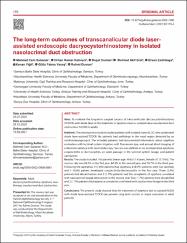The long-term outcomes of transcanalicular diode laserassisted endoscopic dacryocystorhinostomy in isolated nasolacrimal duct obstruction

Göster/
Erişim
info:eu-repo/semantics/openAccessTarih
2021Yazar
Sabaner, Mehmet CemKahveci, Orhan Kemal
Duman, Reşat
Erol, Mehmet Akif
Çetinkaya, Ersan
Yiğit, Kenan
Yavaş, Güliz Fatma
Duman, Rahmi
Üst veri
Tüm öğe kaydını gösterKünye
Sabaner, M. C., Kahveci, O. K., Duman, R., Erol, M. A., Çetinkaya, E., Yiğit, K., ... & Duman, R. (2021). The long-term outcomes of transcanalicular diode laser-assisted endoscopic dacryocystorhinostomy in isolated nasolacrimal duct obstruction. Gülhane Tıp Dergisi, 63(3), 170-174.Özet
Aims: To evaluate the long-term surgical success of transcanalicular dacryocystorhinostomy
(TCDCR) with diode-laser in the treatment of epiphora due to isolated naive nasolacrimal duct
obstruction (NLDO) in adults.
Methods: This retrospective study included patients with isolated naive NLDO, who underwent
diode laser-assisted TCDCR. No patients had pathology in the nasal region detected by an
otorhinolaryngologist. The included patients had documented information about epiphora
evaluation with lacrimal system irrigation with fluorescein dye, and annual direct imaging of
osteotomy patency with nasal endoscopy. Success was defined as no postoperative epiphora,
conjunctivitis or dacryocystitis, an open passage in the lacrimal system lavage, and patient
satisfaction.
Results: The study included 116 patients [mean age: 49.6±11.4 years, female: 67 (57.8%)]. The
success rate was 84.5% in the first year, 80.2% in the second year, and 76.7% in the third year.
Following the operation, 9 (7.8%) patients had epiphora, 8 (6.9%) patients were not satisfied,
and 1 (0.8%) patient developed conjunctivitis/dacryocystitis in the first year. Three (2.6%)
patients had dissatisfaction and 2 (1.7%) patients had the complaints of epiphora correlated
with nasolacrimal lavage obstruction in the second year. Two (1.7%) patients were dissatisfied
and 2 (1.7%) patients had epiphora complaints confirmed with nasolacrimal lavage in the third
year.
Conclusions: The present study showed that the treatment of epiphora due to isolated NLDO
with diode laser-assisted TCDCR can provide long-term success in major outcomes in adult
patients.















